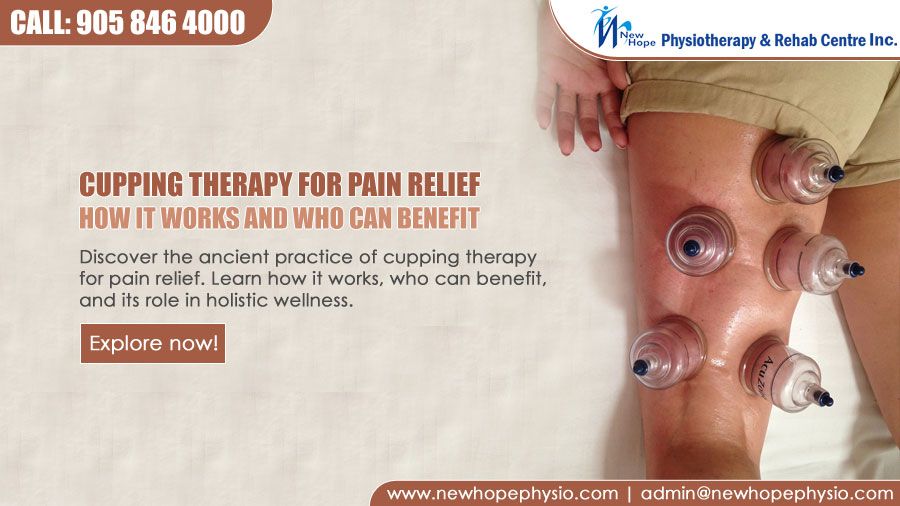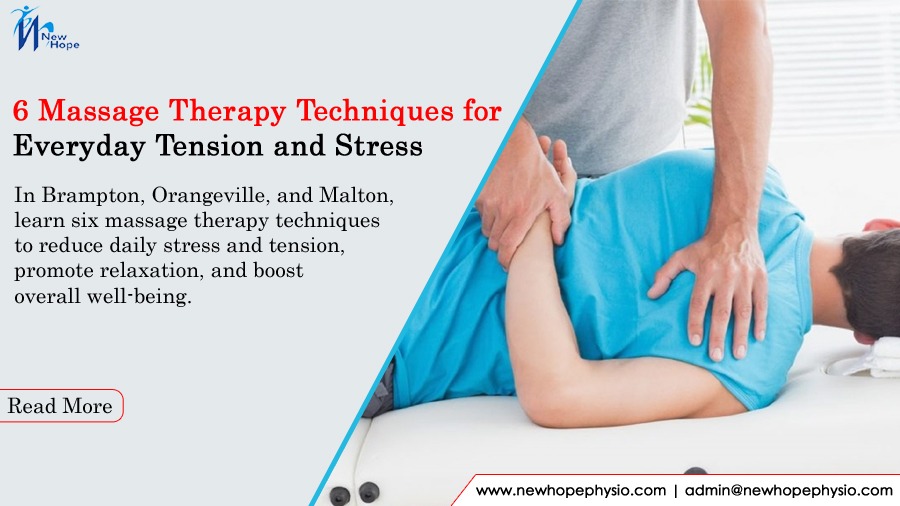
Welcome to the professional physiotherapy clinic
- Home
- Blog
Cupping Therapy for Pain Relief: How It Works and Who Can Benefit
 27 May 2023
27 May 2023
Cupping Therapy for Pain Relief: How It Works and Who Can Benefit
In recent years, cupping therapy has gained significant recognition as a popular alternative therapy for pain relief and overall well-being. With its roots deeply embedded in ancient healing practices and cultural traditions, cupping therapy offers a unique approach to managing pain and promoting holistic health. In this blog, we will delve into the world of cupping therapy, understanding its definition, exploring its historical significance, and examining its rising popularity in modern times.
A. Definition and Overview of Cupping Therapy:
Cupping therapy is a therapeutic technique that involves the use of suction cups placed on the skin to create a vacuum-like effect. These cups can be made from various materials such as glass, bamboo, or silicone. By creating suction on the skin’s surface, cupping therapy aims to stimulate blood flow, energy circulation, and promote healing within the body. It is a non-invasive and ancient practice that has garnered attention for its potential in pain relief and overall wellness.
B. Explanation of Historical Roots and Cultural Significance:
Cupping therapy has a rich historical background that spans across different cultures and civilizations. Its origins can be traced back to ancient Egyptian, Chinese, and Middle Eastern civilizations, where it was used as a traditional healing practice. Cupping therapy was embraced as a means to balance the body’s energy, improve blood flow, and promote overall well-being. This therapy holds cultural significance in various traditions and was passed down through generations as a revered healing modality.
C. Brief Mention of Growing Popularity in Modern Times:
In recent years, cupping therapy has experienced a resurgence in popularity, attracting attention from individuals seeking alternative approaches to pain management and wellness. This renewed interest can be attributed to several factors, including increased awareness of traditional healing practices, growing acceptance of complementary therapies, and the influence of prominent figures in sports and entertainment who have openly embraced cupping therapy. As people continue to explore natural and holistic healing modalities, cupping therapy has emerged as a sought-after option for pain relief and overall health improvement.
In the subsequent sections of this blog, we will delve deeper into understanding the mechanics of cupping therapy, its specific applications for pain relief, and who can benefit from this ancient therapeutic technique.
Understanding Cupping Therapy
A. Explanation of Cupping Therapy Technique:
Cupping therapy encompasses various techniques that involve the application of suction cups to the skin. Here are the different types of cupping therapy:
Dry Cupping: In dry cupping, the cups are placed directly on the skin’s surface, creating a suction effect without any incisions or bloodletting.
Wet Cupping: Wet cupping involves a two-step process. First, the cups are applied to the skin to create suction. Then, small incisions are made on the skin, and the cups are reapplied to draw out a small amount of blood.
Fire Cupping: Fire cupping utilizes a flame to create heat inside the cup, which is quickly placed on the skin. As the air inside the cup cools down, it creates a vacuum effect, creating suction on the skin.
The choice of cupping technique depends on the individual’s needs and the practitioner’s expertise.
Materials Used:
Cupping therapy employs various materials for the cups:
Glass Cups: Glass cups are the traditional choice and are heated briefly to create suction.
Bamboo Cups: Bamboo cups are a popular option in traditional Chinese cupping therapy. They are lightweight and can be easily controlled during the cupping process.
Silicone Cups: Silicone cups have gained popularity in recent years due to their flexibility, ease of use, and the ability to control the suction level.
B. How Cupping Works:
Cupping therapy works by creating a suction and negative pressure on the skin, underlying tissues, and muscles. This suction effect helps in the following ways:
Creation of Suction and Negative Pressure: When the cups are placed on the skin, the air inside the cup is heated or removed, creating a vacuum. This vacuum effect pulls the skin and tissues upward into the cup.
Effects on the Body’s Tissues and Energy Flow: The suction created by cupping therapy helps to increase blood circulation, stimulate lymphatic flow, and release fascial adhesions. It is believed to improve the flow of vital energy (qi) in traditional Chinese medicine.
C. Benefits of Cupping Therapy:
Cupping therapy offers a range of benefits beyond pain relief:
Pain Relief: Cupping therapy has been known to alleviate various types of pain, including muscle soreness, tension headaches, and sports injuries. The suction and negative pressure can help reduce inflammation and promote healing.
Improved Circulation: The suction created by cupping therapy helps to increase blood flow to the treated area, promoting the delivery of oxygen, nutrients, and immune cells. This enhanced circulation can aid in the healing process.
Muscle Relaxation: Cupping therapy can help relax tense muscles and alleviate muscle stiffness. The suction effect can release muscle knots, improve range of motion, and enhance muscle recovery.
Detoxification and Immune System Stimulation: Cupping therapy is believed to stimulate the lymphatic system, aiding in detoxification by eliminating toxins and waste products from the body. Additionally, it may help boost the immune system by enhancing lymphatic flow and promoting the production of immune cells.
Cupping Therapy for Pain Relief
A. Understanding Pain and Its Causes:
Pain is a complex and subjective experience that can result from various factors such as injury, inflammation, muscle tension, or underlying medical conditions. It can manifest as acute pain from a recent injury or chronic pain that persists over an extended period. Understanding the causes and mechanisms of pain is crucial in exploring how cupping therapy can provide relief.
B. Mechanisms of Cupping Therapy for Pain Relief:
Cupping therapy offers several mechanisms that contribute to its effectiveness in relieving pain:
Increased Blood Flow to the Affected Area: The suction created by cupping therapy draws blood to the targeted area, increasing circulation. Improved blood flow delivers oxygen, nutrients, and immune cells, promoting healing and reducing pain.
Release of Tension and Muscle Knots: Cupping therapy helps release tension and tightness in muscles and fascia. The suction effect can loosen muscle knots and adhesions, reducing pain and stiffness associated with muscular imbalances or injuries.
Triggering the Body’s Natural Pain-Relieving Responses: Cupping therapy stimulates the body’s natural pain-relieving mechanisms. The suction can activate the release of endorphins, serotonin, and other neurochemicals that help alleviate pain, improve mood, and induce relaxation.
C. Conditions and Ailments That Can Be Treated with Cupping Therapy:
Cupping therapy has shown promise in treating various conditions and ailments associated with pain:
Musculoskeletal Pain: Cupping therapy can be beneficial for individuals experiencing musculoskeletal pain, including back pain, neck pain, and joint pain. It helps alleviate tension, improve blood flow, and promote healing in affected areas.
Headaches and Migraines: Cupping therapy has been reported to provide relief for tension headaches and migraines. The relaxation and increased blood flow achieved through cupping may help reduce the frequency and intensity of headaches.
Sports Injuries: Cupping therapy is commonly used in sports medicine to aid in the recovery and rehabilitation of sports-related injuries. It can help reduce inflammation, enhance tissue healing, and relieve muscle soreness.
Fibromyalgia and Chronic Pain: Cupping therapy may offer relief for individuals with fibromyalgia and chronic pain conditions. It can help alleviate pain symptoms, improve circulation, and promote relaxation, potentially enhancing overall quality of life.
Arthritis and Rheumatic Conditions: Cupping therapy has been utilized as a complementary approach for managing pain associated with arthritis and rheumatic conditions. It can help reduce joint inflammation, improve mobility, and provide localized pain relief.
By incorporating cupping therapy into a comprehensive pain management plan, individuals with these conditions may experience improved pain control and a better quality of life.
Who Can Benefit from Cupping Therapy
Cupping therapy offers a range of benefits that make it suitable for various individuals seeking alternative pain management methods and overall well-being. Here are the groups of people who can benefit from cupping therapy:
A. Individuals Seeking Alternative Pain Management Methods:
For those looking beyond conventional approaches to pain management, cupping therapy provides a non-invasive and drug-free option. It can be especially beneficial for individuals who prefer natural remedies, have concerns about medication side effects, or want to explore complementary therapies alongside conventional treatments.
B. Athletes and Active Individuals:
Athletes and active individuals often experience muscle strains, sports injuries, and muscle tightness. Cupping therapy can be a valuable addition to their recovery and performance enhancement strategies. It can help reduce inflammation, promote faster healing, relieve muscle soreness, and improve range of motion, allowing athletes to return to their activities more quickly.
C. Those with Chronic Pain Conditions:
Individuals living with chronic pain conditions, such as fibromyalgia, arthritis, or neuropathy, can find relief through cupping therapy. It offers a holistic approach to managing pain by targeting specific areas, reducing inflammation, relaxing muscles, and enhancing blood flow. Cupping therapy can be integrated into a comprehensive pain management plan, potentially reducing reliance on pain medications.
D. People Seeking Stress Relief and Relaxation:
Cupping therapy is not limited to physical benefits but also provides significant psychological and emotional relief. The relaxation induced by cupping therapy helps reduce stress, anxiety, and tension. The gentle suction and massage-like effect of cupping can promote a sense of calmness, aiding in relaxation and overall well-being.
E. Individuals Looking for Detoxification and Immune System Support:
Cupping therapy has been associated with detoxification benefits, as it stimulates the lymphatic system and aids in the elimination of toxins from the body. Additionally, by improving blood circulation and promoting immune system responses, cupping therapy can support the body’s natural defense mechanisms, potentially boosting immune function.
It is important to note that cupping therapy should be administered by trained professionals who understand the technique and its appropriate applications. Seeking the guidance of a licensed cupping therapy practitioner ensures safety and optimal results.
Safety and Considerations
While cupping therapy is generally considered safe, it is essential to be aware of potential side effects, take necessary precautions, and seek professional guidance. Here are some important safety considerations when it comes to cupping therapy:
A. Possible Side Effects and Risks of Cupping Therapy:
Skin Discoloration: Cupping therapy can cause temporary discoloration or bruising on the skin. These marks are not typically painful and fade within a few days to a couple of weeks.
Skin Sensitivity: Some individuals may experience skin sensitivity or mild discomfort during or after cupping therapy. This can vary depending on individual pain thresholds and the intensity of the treatment.
Dizziness or Lightheadedness: In rare cases, individuals may feel lightheaded or dizzy during or after cupping therapy. This can occur due to changes in blood flow and should subside quickly. It is advisable to rest and hydrate after a session.
B. Precautions and Contraindications:
Broken or Damaged Skin: Cupping therapy should not performed on areas with open wounds, cuts, or rashes, as it can potentially worsen the condition or lead to infection.
Bleeding Disorders or Anticoagulant Medication: Individuals with bleeding disorders or taking anticoagulant medications should consult with their healthcare provider before undergoing cupping therapy. Wet cupping, which involves bloodletting, generally contraindicated for such individuals.
Pregnancy: While cupping therapy generally considered safe during pregnancy, it is crucial to consult with a healthcare professional before proceeding, as certain areas and techniques may need to avoided.
Deep Vein Thrombosis (DVT) or Thrombophlebitis: Cupping therapy should avoided in areas affected by DVT or thrombophlebitis, as it can potentially dislodge blood clots or worsen the condition.
C. Importance of Seeking Professional Cupping Therapy Practitioners:
To ensure safe and effective cupping therapy, it is essential to seek professional practitioners who trained and experienced in this technique. Professional cupping therapy practitioners can assess individual needs, determine the appropriate cupping technique, and apply the therapy safely. They can also provide post-treatment care instructions and monitor any adverse reactions or contraindications.
Conclusion
Cupping therapy offers a centuries-old technique that has gained popularity in modern times as a complementary treatment for pain relief and overall well-being. By understanding its technique, benefits, and safety considerations, individuals can make informed decisions about incorporating cupping therapy into their health and wellness routine.
Throughout this blog, we explored the following key points:
A. Recap of Cupping Therapy’s Benefits for Pain Relief:
Cupping therapy provides pain relief through increased blood flow, muscle relaxation, and the triggering of natural pain-relieving mechanisms. It has shown efficacy in addressing musculoskeletal pain, headaches, sports injuries, chronic pain conditions, and arthritis.
B. Encouragement to Explore Cupping Therapy as a Complementary Treatment Option:
If you are seeking alternative pain management methods, improved circulation, relaxation, or immune system support, cupping therapy may be worth exploring. It offers a non-invasive and drug-free approach that can integrated into your overall wellness routine.
C. Closing Thoughts on Its Potential as Part of a Holistic Approach to Wellness:
Cupping therapy is not a standalone solution but rather a valuable component of a holistic approach to wellness. It should used in conjunction with other treatments, exercise, proper nutrition, and self-care practices. By addressing physical, emotional, and energetic aspects, cupping therapy contributes to a comprehensive approach to well-being.
Remember, it is important to consult with a qualified cupping therapy practitioner who can tailor the treatment to your specific needs and ensure your safety and optimal results. They can guide you through the process, answer your questions, and provide individualized care.
Incorporating cupping therapy into your wellness routine can be an empowering step towards better pain management, relaxation, and overall health. By embracing the ancient wisdom of cupping therapy and its modern applications, you can embark on a journey towards improved well-being and a more balanced life.
Recent Posts
All Categories
- Acupuncture
- Arthritis
- Back Pain
- Chiropractic
- Chronic Pain
- Cupping Therapy
- Exercise
- Fibromyalgia
- Headaches
- Health
- Injury Clinic
- Joint Pain
- K Taping Therapy
- Knee pain
- Laser Therapy
- Manual Therapy
- Massage Therapist
- Mental Health
- Neck Pain
- Nerve pain
- Orthotic
- pelvic floor physiotherapy
- Physiotherapy
- Sciatica Pain
- Scoliosis Exercises
- Shockwave Therapy
- Shoulder pain
- Sports Physiotherapy
- VRT



Leave a Comment